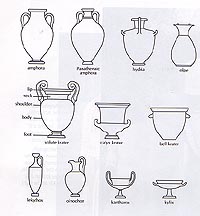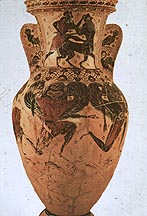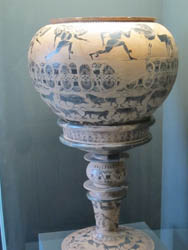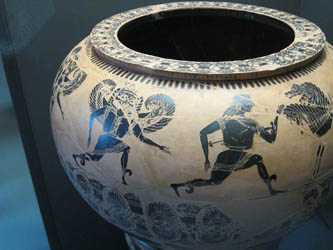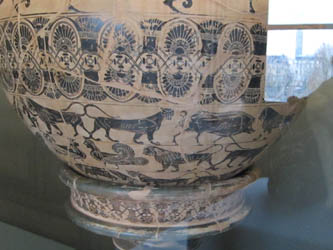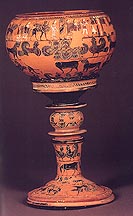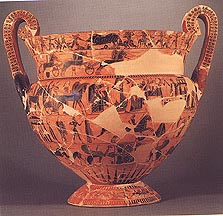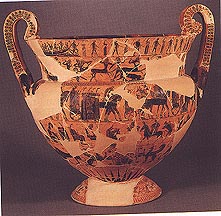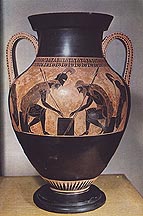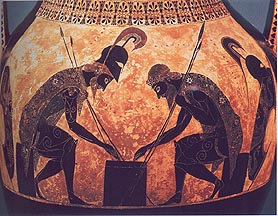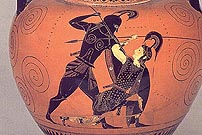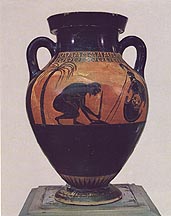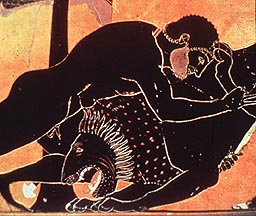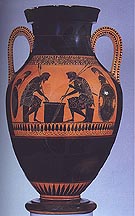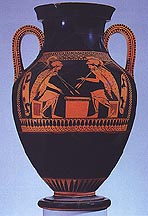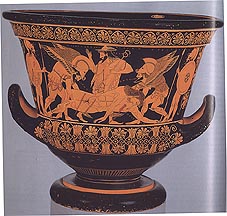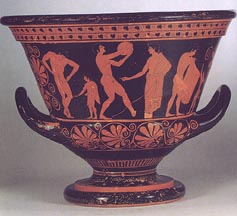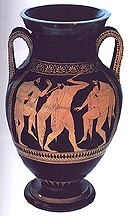Art Home | ARTH Courses | ARTH 209 Assignments
Archaic Vase Painting
Chigi Vase (Olpe), Corinthian, c. 640 B.C.
Nessos Amphora, Attic black figure Amphora, last quarter of the seventh century B.C.
Attic Dinos by the Gorgon Painter, c. 580 BCE |
|
Dinos (mixing bowl), signed by Sophilos (in the porch of Peleus' house is written: Sophilos egraphsen, "Sophilos painted [me]"), first quarter of the sixth century. The upper register illustrates the procession of divine guests at the wedding of Peleus to the sea-goddess Thetis. Note that the gods are carefully identified by names.
"François Vase", volute krater signed by Kleitias as painter and Ergotimos as potter, end of the first quarter of the sixth century B.C. For more images of the François Vase and the identification of the subject matter of the different scenes see the entry for the vase in Perseus.
Amphora signed by Exekias with Achilles and Ajax at play.Third quarter of the sixth century B.C.
Amphora signed by Exekias as potter, third quarter of the sixth century. Depicts Achilles Slaying Penthesilea.
Amphora by Exekias, c. 530 B.C. Suicide of Ajax.
Psiax, Herakles Strangling the Nemean Lion, amphora, c. 525 B.C.
Andokides Painter , Achilles and Ajax playing dice (Attic bilingual amphora), c. 525-520.
Andokides is the name of the potter; the painter is anonymous.
Euphronios, Herakles Wrestling Antaios (Attic red-figure calyx krater), c. 510 B.C.
Euphronios (painter) and Euxitheos (potter), Death of Sarpedon, c. 515 B.C.
(Accordining to Homer's Iliad, Sarpedon, a son of Zeus and a mortal woman, was killed by the Greek warrior Patroclus while fighting for the Trojans. Euphronios shows the winged figures of Hypnos (Sleep) and Thanatos (Death) carryin the dead warrior from the battlefield. Watching over the scene is Hermes, the messenger of the gods, identified by his winged hat and caduces, a staff with coiled snakes. Hermes is there in another important role, as the guide who leads the dead to the netherworld.
Euphronios, Attic red-figure calyx krater, end of the sixth century.
Euthymides, Revelers, red -figure amphora, c. 510 B.C.
Added to the customary "Euthymides painted me" is the phrase "as never Euphronios [could do]!"
